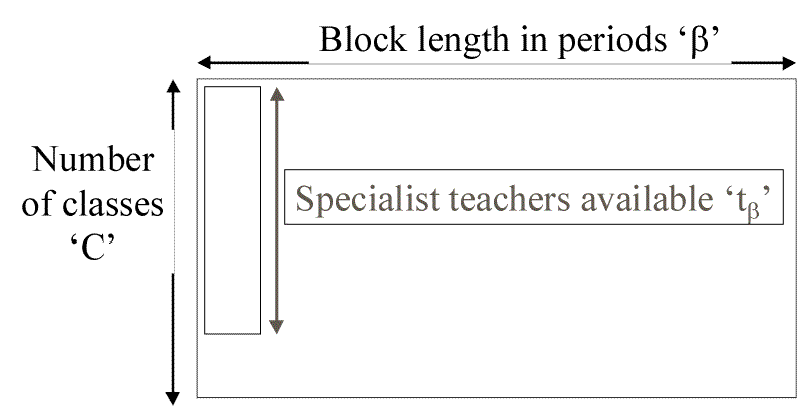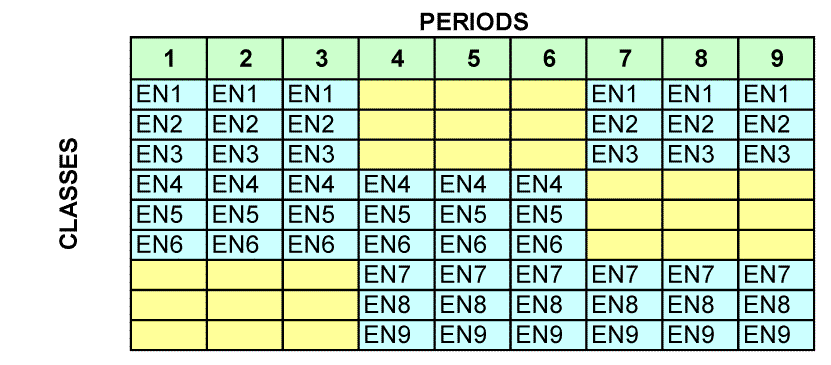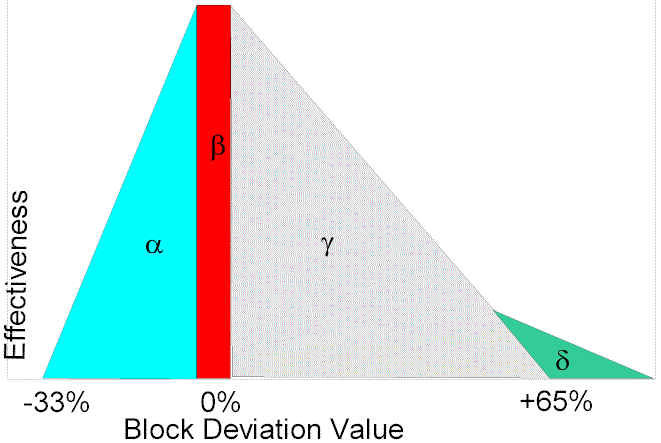Time Blocking
©Dean Ashton
The Concept
At some point in time, all curriculum managers have to apply their curriculum framework to the reality of a timetable. The ideals of curriculum entitlement, operational staffing needs, contact time policy and pupil grouping policy clash with the expediency of bringing together students, teachers, subjects and rooms on a timetable. The concept of pupil groupings is not considered within ideas such as the 'operational staffing need' and yet it is critical to the effective delivery of the curriculum. Time Blocking provides a theoretical framework for bridging the gap between the curriculum plan and the timetable that includes the concept of pupil grouping.
Time Blocking has been developed in two distinct phases:
- Ideal Blocks
- Contextualised Blocks
Ideal Blocks are, as their name suggests, an optimised theoretically structured timetable block. Their real value lies in their property of to provide a theoretical basis for creating Contextualised Blocks.
Contextualised Blocks are real timetable blocks set within the context of an actual staffing structure and curriculum framework. Time Blocking provides a means of calculating the optimum number of periods that these blocks should occupy in a defined timetable structure.
Timetable Blocks
In order that students can be grouped in the most appropriate manner for the effective delivery of a curriculum area, it is essential that the timetable provides maximum autonomy for each curriculum area to do this independently of all other curriculum areas. No assumption is made here about the nature of that grouping! The single most effective way of achieving this is block timetabling.
The ideal timetable block provides a single curriculum area with a whole year group at the same time. This allows the curriculum area to organise and re-organise the students as they see fit, independently of all other curriculum areas. Unfortunately, many curriculum areas will not have enough specialist teachers to be able to do this and so alternative strategies must be found to achieve the same ends. One alternative strategy is to pair subjects together that share a common student grouping policy, and thus create a timetable block composed of both subject areas.
We can easily calculate the minimum number of periods that such a block needs to occupy on the timetable. For example, if the number of the classes in the year group is ‘C’, and the number of specialist teachers available to teach a specific subject is ‘tb’, and each class is entitled to study the subject for ‘p’ periods per week, then the minimum size for the time table block in terms of periods ‘ b’ will be:
b =
C . p / tb

For Example: English is taught to every students for six periods per week (p = 6), in a nine form entry year (C = 9). Six English teachers are available (tb = 6).
b = C . p / tb
= 9 periods

Ideal Blocks - bideal
An IDEAL block assumes:
- The number of periods that a subject is taught for in each year is identical
- The block size, in periods ‘b’, is the same in all years
- The number of staff teaching in the block at any one time is the maximum possible, i.e. the Operational Staffing Need T.
The size of an ideal block, in periods per week, can be calculated as follows:
The Operational Staffing Need approximates to:
T » Tmin » C.p / ts
Over all n years:
T » Tmin » n .
C.p / tsAssuming tb = T, then for an ideal block:
tb = n .C.p / ts= P / ts
So, the number of teachers available to teach an ideal block tb = n . C.p / ts
but, the size of a block, in periods, is given by b = C.p / tb
Substituting one in to the other, gives us the size of an ideal block to be:
bideal = C.p / (n. C.p /ts) = ts / n
The ideal block represents an optimum size in terms of:
- Maximum use of specialist teaching staff
- Maximum autonomy for subjects to determine student groupings
- Minimum size to prevent timetable clashes.
Deviation from the Ideal
Block sizes can be reduced from the ideal if extra staff, over and above the T value, can be made available. 50% more staff will allow us to reduce the block size by 33%.
A timetable block that is up to 33% smaller than the ideal block size must compromise effective staffing. They would benefit however by maximising autonomy for student grouping and improve timetable scheduling.
Timetable blocks could be increased in size by up to 65% of the ideal size, if it is to be taught to only 3 years out of 5, though timetable clashes are more likely. Larger blocks require less teachers for each subject taught at any one time and thus improve the flexibility of assigning individual timetables. Autonomy of student grouping will be compromised in a larger block.
This deviation from ideal block size can be represented by the following diagram.

'Block Deviation Value' = (b - b ideal)/(bideal) * 100
For example: If an 11-16 comprehensive school operated a 45 period timetable, and the average contact time for a teacher with no additional responsibilities was 40 periods, then the ideal block would occupy bideal = ts / n = 40 / 5 = 8 periods.
If P.E. and English were taught in a timetable block at key stage 3, that occupied a total of 7 periods, then the block variation would be (7 - 8)/8 *100 = -12.5%, placing it in the a region of the chart.
The position of a real block on the chart implies the following characteristics:
- a region
- Easy to schedule on a timetable
- Staffing compromised - requires more teachers than operational staffing need
- Greater autonmoy of student grouping
- b region
- Ideal block - optimum for timetable scheduling.
- Optimum staffing - matches operational staffing need
- Optimum autonomy for student grouping
- g region
- Difficult to schedule, the block is likely to clash with similar blocks on the timetable
- Greater flexibility for assigning teachers to classes - less teachers required than the operational staffing need
- Reduced autonomy of student grouping for each subject area within the block
- d region
- The same features as the g region but further emphasised.
Contextualised Blocks
bideal is calculated on the assumption that:
tb » T » P / ts
This ignores the effects of differential non-contact time and the common tutor period.
Both of these effects are taken in to account by the full equation for the ‘Operational Staffing Need’ however.
T = (1/ts)(P + f)(1 + q / ts) - (nt . q / ts)
Thus, if b = P / T then the size of a contextualised block bcontext is given by:
bcontext = b ideal / (1 + q/ts + tnct / P)
Where:
q/ts takes accounts of the effects of a common tutor period on bideal.
and,
tnct is a function of the nett additional non-contact time for management time
tnct = f + q / ts(f - nt . ts)
The equation for bcontext can now be applied to actual staffing structures and curriculum models in order to identify the optimum block size for any curriculum subject. Costing the Curriculum software, uniquely incorporates the Contextualised Block equation and automatically calculates its value for each subject area.
